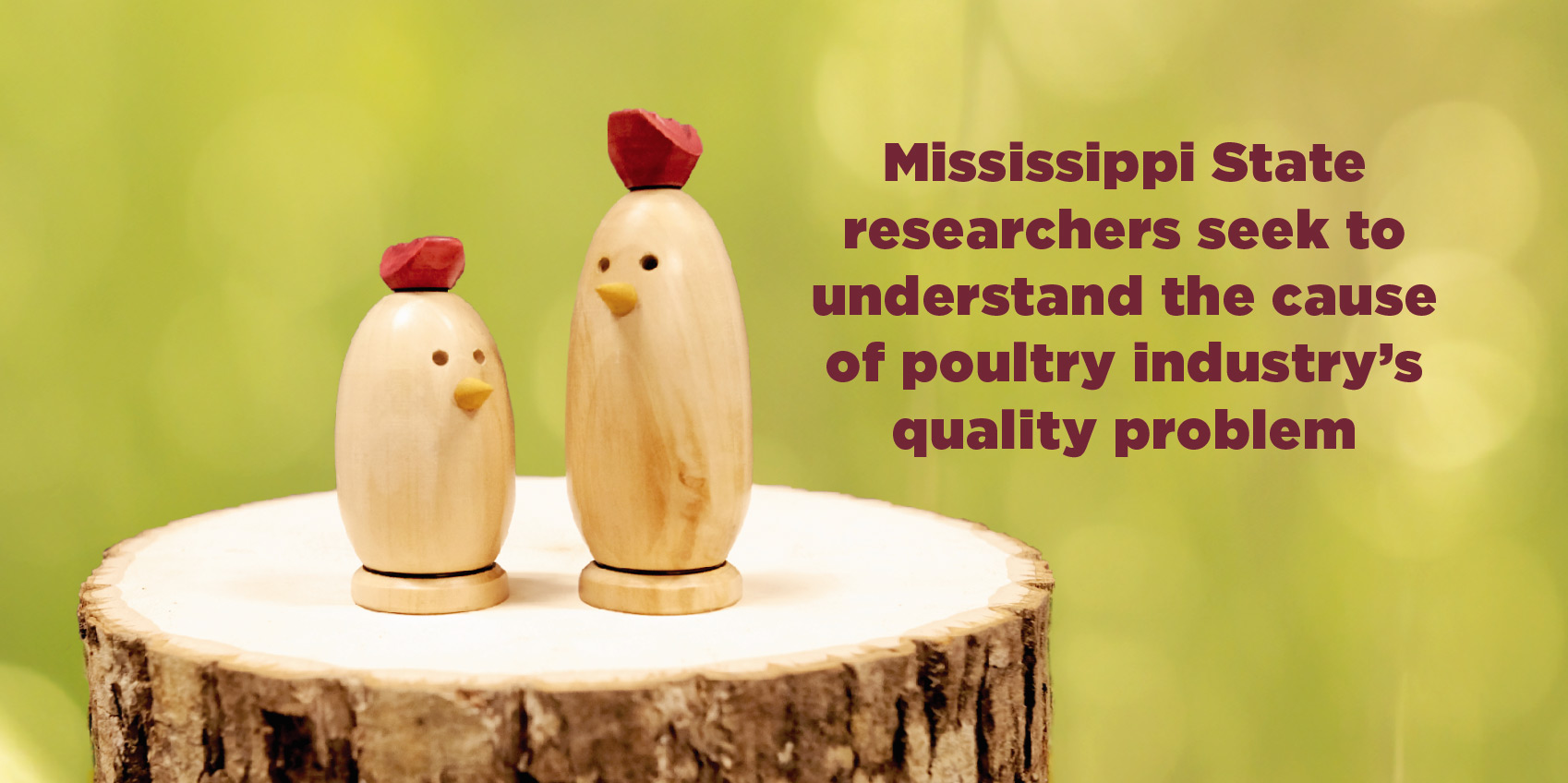
When it comes to meat consumption in the United States, chicken rules the roost. Last year, the average American consumed more than 100 pounds of chicken meat—more than twice the amount per capita compared to 40 years ago.
Improved breeding and processing techniques—and, consequently, lower prices—have bolstered the once humble bird to the top of the culinary pecking order. Over the years, however, a growing national hunger for this affordable protein has accelerated not only the growth of birds, but also a troubling meat quality issue.
An abnormal muscle condition known as “woody breast” affects the texture of some broiler chickens’ breast meat. The meat is safe to eat, but it is unusually coarse, crunchy and generally less appealing to consumers—equating to economic losses to the chicken industry, a $20 billion economic driver for Mississippi.
As the most significant meat-quality issue for the poultry industry, woody breast is responsible for a nationwide economic loss of approximately $200 million annually. For over a decade, the whats, whys and hows of the costly disorder have remained elusive, but now, a team of Mississippi State researchers led by Wes Schilling is seeking to understand the disorder and develop solutions.
“When woody breast was first discovered in Europe and the U.S., it received a lot of media attention,” said Schilling, a professor in the Department of Food Science, Nutrition and Health Promotion. “Today, it is no less prevalent, but people in the industry are more aware and will ensure that a severely affected breast won’t make its way to the consumer.”
 “Today, chickens are bred to develop muscle quickly, but this results in a skeleton that can’t keep up with that growth.” ~ Wes Schilling
“Today, chickens are bred to develop muscle quickly, but this results in a skeleton that can’t keep up with that growth.” ~ Wes Schilling
Broiler breeds that experience rapid muscular growth and development of large breasts are more likely to produce higher percentages of woody breast.
“Today, chickens are bred to develop muscle quickly, but this results in a skeleton that can’t keep up with that growth,” Schilling said. “To maintain homeostasis, the bird will begin to develop muscle that has more collagen—connective tissue protein—than meat protein, and it also puts on more fat.”
However, while genetics predispose the birds to the condition, the team has found that environmental triggers can also play a role. Xue Zhang, who studies the structure and function of proteins, has been a key contributor to the woody breast study as an assistant research professor.
“Some of the proteins we found in the woody breast tissue are indicators of stress,” Zhang said, “but we cannot say definitively that these expressions are the cause of woody breast.”
To better understand environmental components of woody breast, Zhang is also studying the microbiome—the colony of microorganisms living in the birds’ digestive tracts. For the moment, trying to identify a microflora origin of woody breast is a chicken-or-egg situation.
“We’ve found differences in the gut microflora of birds with and without woody breast,” she said. “However, we’re not sure whether woody breast causes those differences in the gut or whether certain microflora in the gut are associated with the bird developing this condition. It’s still too early to draw conclusions.”
 “We’ve found differences in the gut microflora of birds with and without woody breast. However, we’re not sure whether woody breast causes those differences in the gut or whether certain microflora in the gut are associated with the bird developing this condition.” ~ Xue Zhang
“We’ve found differences in the gut microflora of birds with and without woody breast. However, we’re not sure whether woody breast causes those differences in the gut or whether certain microflora in the gut are associated with the bird developing this condition.” ~ Xue Zhang
With their first five-year study drawing to a close, Schilling and Zhang have discovered several physical differences between birds affected by woody breast and those that are not. These revelations were published in prominent peer-reviewed journals including Poultry Science, the Journal of Agricultural and Food Chemistry, and Meat and Muscle Biology.
More research, however, is needed to get to the root of the problem. The team is collaborating with scientists from the poultry science department and MSU’s Institute for Genomics, Biocomputing and Biotechnology to examine the gene expression at the RNA level.
The team is also beginning to examine brain tissue to identify genetic markers related to neuron development. Zhang said she hopes to discover how the birds’ neuro-systemic responses to environmental conditions affect woody breast. That insight will further illuminate how the disorder develops.
“This condition is much more complex than I thought it would be,” Schilling admitted. “Consumer demand has increased the need for chicken, and the industry has responded to that demand. Scientists will need to continue to search for answers and solutions.”
While the science is still out on what causes woody breast—genetics or environment, or a combination of the two—MSU researchers are committed to studying the issue so consumers continue to enjoy this delicious source of protein.

Poultry is Mississippi’s largest agricultural industry with over $3 billion paid to growers and direct employment of more than 28,000 people.
It is estimated that the poultry industry brings in $20 billion dollars to the state’s economy and pays over $1.5 billion in federal, state and local taxes.
MSU poultry science graduates enjoy 100% placement with the poultry industry, often fielding more than one job offer.

